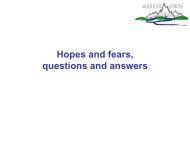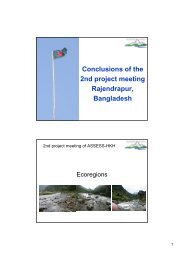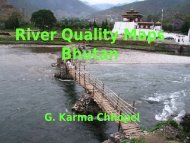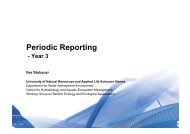2007 - ASSESS-HKH
2007 - ASSESS-HKH
2007 - ASSESS-HKH
Create successful ePaper yourself
Turn your PDF publications into a flip-book with our unique Google optimized e-Paper software.
UDE will compile abstracts in co-operation with KU. Decision on which talks are accepted will<br />
be done by scientific committee.<br />
O. Moog pointed out that specific plans for dissemination and end-users and how they will be<br />
used were not adequately presented earlier session. We need to re-discuss these in the<br />
afternoon session.<br />
Lunch break<br />
Afternoon of Day 3: continuation of Session 6<br />
O. Moog: All Asian partners should please provide a list of contacts (end-users) and specific<br />
plans for further dissemination and continuation of the work beyond the life of the project.<br />
S. Sharma compiles answers in power point;<br />
see presentation session6_Summary_dissemination_plans_S_Sharma.pdf<br />
1. Bangladesh: contacts with Dept. of Environ. and Save to Environment who are keen to<br />
learn and apply the method of bio-assessment for river water quality monitoring. Also<br />
contacted World Bank and Energy Generation Corporation of Bangladesh (EGCB) who<br />
are willing to support further work on river bio-monitoring and applications in EIA. Dhaka<br />
Univ., Agriculture University of Bangladesh and BUET.<br />
How will the tools be used Mainly for water quality mapping and as an aid in EIA primarily<br />
for policy making related to water quality management and mitigation as well as for<br />
charging users for maintenance of good water quality.<br />
Save the Environment will use it in education and training of public.<br />
WB – only interested in supporting consultants in EIA studies who use this method.<br />
Dept. of Fisheries – interested, but not sure how it will be used.<br />
Moog suggested to contact fish biologists at the Dhaka University to probably start a<br />
cooperation on fish-fish food relations.<br />
2. Bhutan: Royal Society for Protection of Nature and local Schools, Clubs and Bhutan<br />
Water Partnership, Ministry of Agriculture, Dept. of Energy and NECS.<br />
How will the tools be used RSPN will use it for conservation activities and as an<br />
awareness generation and monitoring tool. Dissemination to school children and other<br />
general public who are interested (part of the nature club curriculum). Bhutan Water<br />
Partnership will be involved in future dissemination to other organizations and the public.<br />
Min. of Agric. is interested to use it for irrigation water quality monitoring. DOE and NECs<br />
will use it for EIA and water management policy and decision recommendations.<br />
3. India: CPCB – Central Pollution Control Board of India has been contacted and is<br />
interested in continuing and expanding work in river quality monitoring. IIT, Roorkee,<br />
environmental biology laboratory.<br />
How will the tools be used It will be used for expanding work in river quality monitoring &<br />
river water quality mapping. IIT, Roorkee, plans to have a bio-monitoring unit and wants to<br />
incorporate it into curriculum for Masters degrees.<br />
4. Nepal: Ministry of Environment, Science & Technology, WWF Nepal, IUCN Nepal,<br />
Higher Secondary Schools, Nature Clubs, Community Medicine and Public Health Org.,<br />
the Dept. of Hydrology & Meteorology and AEC-KU.<br />
How will the tools be used It will be used for EIA by the Ministry; for monitoring by WWF<br />
Nepal, IUCN, ENPHO and JICA; research and teaching (course curriculum) and<br />
consultancies by AEC-KU/TU-IOM; DHM – data base compilation and mapping; and for<br />
public awareness by schools and nature clubs.<br />
14






